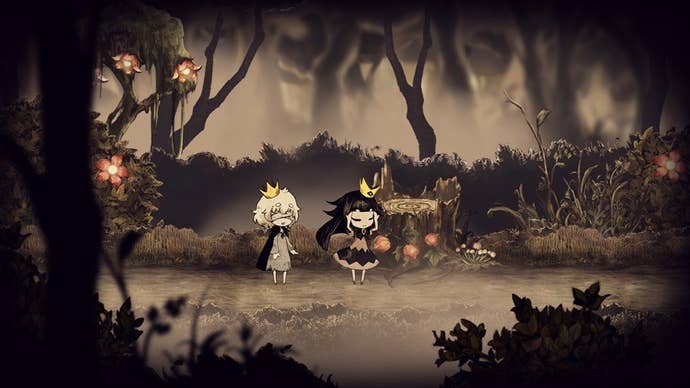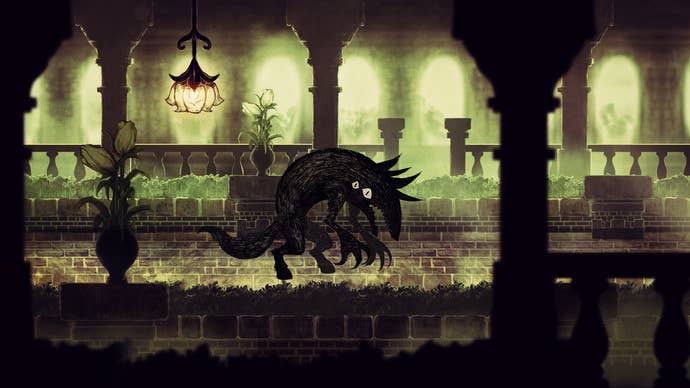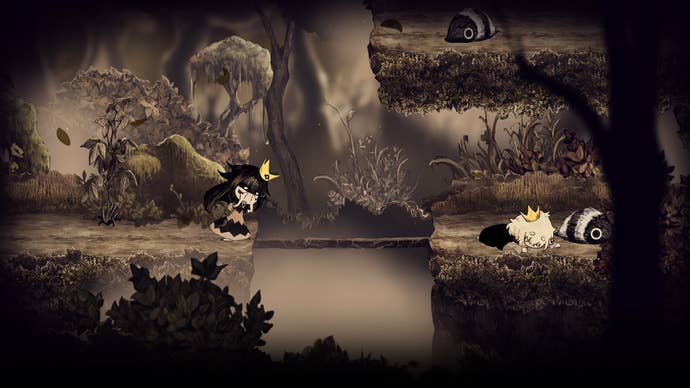How a Blind Prince is Guiding NIS to a Better Future
With the help of a monstrous princess… and many talented up-and-comers.
This article first appeared on USgamer, a partner publication of VG247. Some content, such as this article, has been migrated to VG247 for posterity after USgamer's closure - but it has not been edited or further vetted by the VG247 team.
NIS America plays a dual role. It functions both as the arm for distributing its Japanese parent company's software in the States, as well as a licensor of promising games by outside studios. So, while NIS and NIS America see a lot of overlap in their release lineups, the two companies' product offerings don't always line up.
Such is the case with Liar Princess and the Blind Prince, an internally developed game slated for release by NIS in Japan later this year. For the moment, Liar Princess doesn't have a western release date, or any indication that it will manage to make its way beyond Japan. The game has enormous promise though, with storybook artwork, a sweet-yet-dark premise worthy of the Brothers Grimm, and gameplay that falls somewhere between Ico and The Lost Vikings.

More importantly though, Liar Princess represents a significant section of NIS' internal business. Its concept emerged from the company's annual internal game jam competition, and it joins the ranks of games like Yomawari (which has freshly been announced for Switch release), htoL#NiQ: The Firefly Diary, and Penny-Punching Princess—all of which got their through the same system.
According to NIS sales director Kenzo Saruhashi, these projects have become a critical part of the company's culture since they debuted a few years ago. "Every year, Nippon Ichi Software does a sort of event where we get people who are not usually involved in the game idea creation process and allow everyone to submit ideas," Saruhashi says. "It's kind of a festival or competition—well, not really a competition, but we take a vote and decide which of these ideas we'd like to produce. This year's game release, The Liar Princess and the Blind Princess, is the one that won last year.
"We've been running this initiative for probably five or six years now. The competition itself is not from people outside the company; it's for people inside the company. You know, we have people who work as game designers, but this is a chance to say, 'Anyone who wants to come up with an idea, we'll throw some money at it.' There are some people who hear about this event and join the company just to be part of it!"
Games like Yomawari and Liar Princess have come about by ditching the company's standard design process and breaking down barriers to creativity. In a sense, it upholds a longstanding tradition in the Japanese games industry of seeking inspiration from outside the box. Many long-running series owe much to fan contests and amateur competitions, with iconic standards like the community-sourcing for Mega Man villain concepts. Even Dragon Quest owes its existence to these contests, as two of the series' original designers got their respective starts by winning programming contests conducted by Enix.
"The way this works is that the person comes up with the idea—in this case, the character design and the idea behind the world—and they're separate from the team that actually builds the game. We have experienced staff on hand to serve as team members and programmers who actually create the design of the game.

"Sometimes the person who comes up with the idea is involved, sometimes they're not. Usually they are. If you take out the person with the original vision and separate them from the game design, you can end up with something broken. So we want to make sure they're always involved so that everything can flow smoothly."
NIS began looking to unexpected sources for new ideas as a matter of necessity. The company has experienced some ups and downs in recent years, and the intent in opening the door to game pitches beyond the standard design teams was to help keep things on a more even keel. "This concept began when we wanted to create a new IP for the company," Saruhashi explains. "You know, Disgaea is our flagship series, but we've had trouble launching another series of similar magnitude. So we thought, 'We want to get new, fresh ideas.'"
The company doesn't initiate these projects with the intent of creating a Disgaea-sized success, Saruhashi explains. Instead, they're meant to diversify the overall lineup and make the publisher less dependent on the success of each new Disgaea sequel. "We usually don't treat these as main titles that we sink tons of money into. They're more like pet projects that people get a little bit of funding for. We don't have any specific genres that we aim for, so all kinds of ideas have come out of this.
"We usually try to hold this event once per year. And we don't officially announce when we'll be opening up the competition in advance. But, we just wrapped the latest one back in February, so the next one will probably take place in May of next year. And the game that was selected this past February you can expect to see next year at BitSummit."
Last year's winner Liar Princess takes the form of a puzzle platformer in which players have to guide two different characters through a complex forest. "At its base, this is a side-scrolling puzzle where you play as the Liar Princess," Saruhashi says. "The princess herself is actually not human—she's a wolf monster. But the prince is blind, so he can't see her, and she's kind of leading him around through this story deeper and deeper into the woods. That's the fundamental thrust of the game.

"The princess herself tells a big lie to the prince: 'I'm a princess, I'm a human princess!' Even though she's really this wolf monster. She actually has a thing for this prince, but she realizes that if he knew she was a big monstrous wolf he'd probably back off. So she pretends to be a human princess."
In action, the game probably most resembles WayForward's modernization of 8-bit classic A Boy And His Blob from the Wii era. Not only does it have a similar hand-drawn visual warmth (albeit spookier), the single-player cooperative design works much along the same lines as well.
"There are a lot of different puzzles, like things where you have to lead the prince to stand on a switch, or to get both characters on switches at the same time by leading the prince to one first and then control the princess to stand on the other. Or there might be a seesaw puzzle… things like that," explains Saruhashi.
"The prince, being blind, really can't do anything on his own. He's helpless, a lot like [Yorda in] Ico. The princess, though, because she's a monster, she has her own weakness: She's afraid of fire. Although the prince can't do much, he can hold lanterns and put out fires. Handling things the princess is afraid of. So he contributes to the quest, too."
All in all, it's a charming little adventure game that represents a welcome change of pace for NIS' lineup. So, will it make its way to the U.S. eventually? Chances seem good, despite the company's silence on the matter so far. To date, only one of NIS' projects to emerge from its internal concept solicitations has failed to leave Japan. And that came down entirely to content issues, as the game in question—Great Edo Blacksmith—was an adventure game with a borderline pornographic dating element. Liar Princess takes a far more innocent and work-safe approach, so it's hard to imagine that it won't be announced for NIS America's PS4 and Switch lineup in the near future. Who knows, maybe even the Vita version will come west. Someone's got to keep those fires burning, after all.
